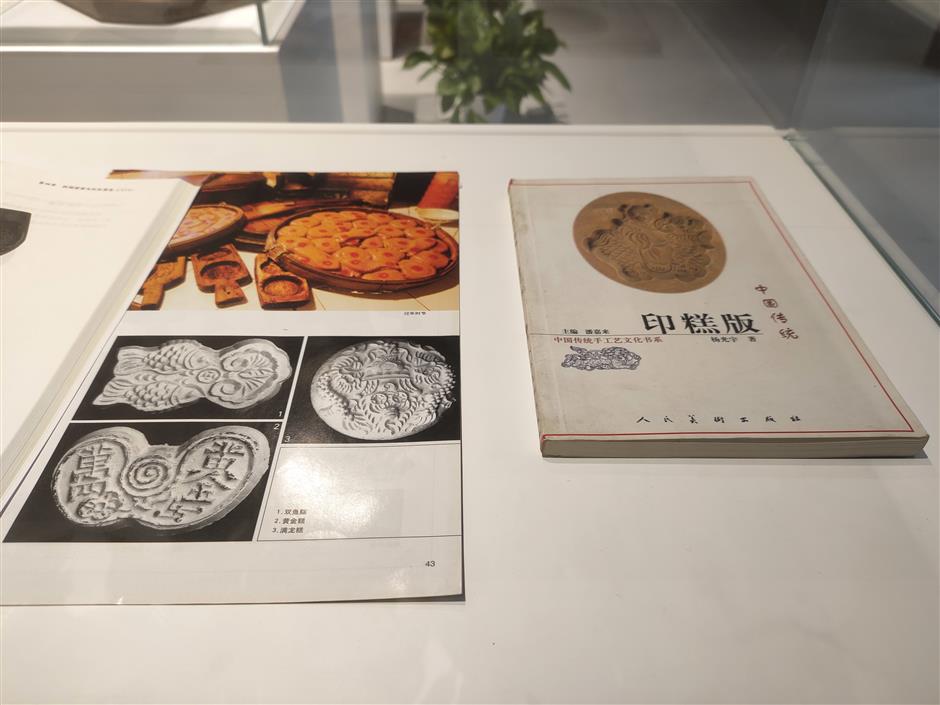Throughout the dynastic eras, people living in Sandun Town made yingao (印糕), or rice cakes, for festive feasts. Some wooden cake molds have been used for centuries and handed down over generations. To some degree, they are not daily utensils, but part of a cultural heritage carrying on local traditions and family bonds.
Huang Shuli has collected such antique molds for years. He recently donated all of his collections to Sandun Town government. Local departments built a Sandun Yingao Molds Art Gallery in an effort to retain the nostalgia of Sandun's past.
"I was born and grew up in Sandun. My father was a carpenter making cake molds, so I was familiar with the patterns and procedures for carving them," said Huang.
"Some handmade crafts are declining along with time. I hope the collection of molds can help younger generations learn about the handicrafts and our ancestors' wisdom."
Shanghai Daily visited the newly built gallery and found some highlights worth a visit. The venue is divided into two sections – the history and molds themselves.
Historically, Sandun Town dates back to 6,500 BC as evidenced at the Fangshan Cultural Relic Site. Remaining archives show the town already existed during the Warring States Period (476-221 BC) when Xunzi, a Confucian philosopher, visited the town to read books and plant orchids.
In the Tang Dynasty (AD 618-907), General Yuchi Gong (worshipped as the door god in Chinese folk religion) led troops to station here. They cut down cedars to build bridges. Therefore, Sandun Town was originally named shandun, which literally means "cedar stumps." In time, the name gradually changed into sandun, literally "three stumps" in Chinese.

Lan Yuyue
Books which chronicle the pattern variations through dynastic eras showcase the history of yingao tradition in Sandun Town.
Sandun developed into a commercial hub when Hangzhou was made the capital of the Southern Song Dynasty (1127-1279). People flocked there to trade and exchange goods.
According to historical documents, Hangzhou was dotted with stores selling about 20 types of rice cakes during that period, which could be attributed to the cultural exchange between south and north China.
Throughout the Yuan (1271-1368), Ming (1368-1644) and Qing (1644-1911) dynasties, the cake varieties expanded, forming the Jing (Beijing), Qin (Shannxi Province), Chuan (Sichuan Province), Ningshao (Ningbo and Shaoxing in Zhejiang Province) and Minyue (Fujian and Guangdong provinces) styles.
"In Sandun, mold patterns varied according to different stages of life," said Huang. "And the molds I collected testify to that."
As the exhibits showcased, some molds were engraved with pomegranate patterns, which symbolize the harvest, prosperity and thriving offspring in Western countries.
Pomegranates spread to the Orient during the Tang Dynasty and soon found favor. Sandun people carved such motifs on the wooden molds to pattern rice cakes, praying for happy marriages and prosperous offspring.

Lan Yuyue
Wooden molds with various patterns are on display at the Sandun Yingao Molds Art Gallery in Sandun Town.
When a baby was born, his or her parents would make rice cakes patterned with the characters Qilin (麒麟) and send them away to relatives and friends sharing their happiness.
In Chinese culture, people believe it is the mythical creature Qilin that carries a baby to the family, similar to how European folklore considers the stork to be responsible for bringing babies to new parents.
If the rice cakes were made to celebrate a senior's birthday, then they would be patterned with Fu (福), Lu (禄), Shou (寿) and Xi (喜), meaning fortune, prosperity, longevity and happiness, respectively, in Chinese, which stand for the four most popular immortals for Chinese people.
The dragon and phoenix patterns were exclusive to emperors and empresses, as they represented sovereignty. Starting from the Republic of China (1912-1949), such patterns were gradually used in wooden cake molds with auspicious meanings.
Flowers are also commonly seen in wooden molds. One of the favorite patterns is the peony, as seen in the exhibits. Known as the "king of flowers," the peony often symbolizes honor, wealth and aristocracy, as well as love, affection and feminine beauty.
Address: 50 Jiangjiaba, Sandun Town, Xihu District
西湖区三墩镇江家坝50号
Read Again https://news.google.com/__i/rss/rd/articles/CBMiNGh0dHBzOi8vd3d3LnNoaW5lLmNuL2ZlYXR1cmUvYXJ0LWN1bHR1cmUvMjIxMTI1MzMzNC_SAQA?oc=5Bagikan Berita Ini














0 Response to "Not a piece of cake but molding traditions get new lease of life - SHINE"
Post a Comment